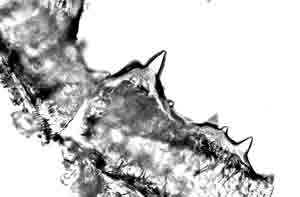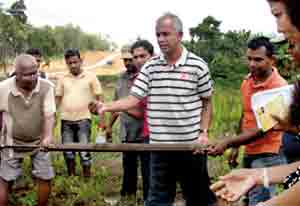How rice cultivation in Sri Lanka may have been linked to Stone Age man
By Asiff Hussein
Believe it or not, rice, our staple crop, was not introduced to our island by Aryan migrants from Eastern India around the 5th century BC as had been previously supposed. Rather its cultivation seems to go back to pre-historic times, in all probability to Sri Lanka’s Stone Age.
This writer, in the course of his research into traditional Sri Lankan foods, often found it intriguing why Sri Lanka had such a vast diversity of traditional rice varieties. There are believed to be no less than a thousand varieties of rice grown in Sri Lanka. Generally speaking, it is a well known principle in genetics as well as other disciplines such as linguistics that the greater the diversity of a given species in a particular area, the greater the antiquity of that species in that region. The origins of rice cultivation in Sri Lanka may therefore go back to several thousands of years based on such hypothetical reasoning.

Needless to say, this in itself is not sufficient ground for establishing the antiquity of rice cultivation in Sri Lanka. Harder, more tangible evidence is necessary to prove it as a certainty. And here we are not on tenuous grounds. Recent research undertaken by Dr. Rathnasiri Premathilake, a pioneer in the field of paleo-ecology and environmental archaeology in Sri Lanka has called into question many of our long held beliefs, among them the idea that rice cultivation was introduced here by iron-using man hailing from northern India. Rather the latest archaeological research seems to suggest that the country’s Stone Age men, ancestors of the aboriginal Veddas, may have been our first farmers.
Dr. Premathilake, a scientist at the Paleo-Ecology Laboratory of the Post Graduate Institute of Archaeology, University of Kelaniya has long been of the view that we could reconstruct our remote past by employing the techniques and methods perfected by the science of environmental archaeology which since its early beginnings in the 1970s has arguably grown to be the most important branch of archaeology today.
This is particularly so in a context of the absence of historic records dealing with the pre-historic era. History as we all know begins with writing and the earliest written records of our history, the Mahavamsa and Dipavamsa do not help us to reach beyond the 5th or 6th century BC. The period beyond this therefore has to be reconstructed using archaeological evidence. Skeletal remains and artifacts like pottery certainly help us in understanding our past lifeways, but these are of limited value in attempting to reconstruct a comprehensive picture of the past. So much of man’s past material culture has been lost due to the ravages of time, adverse climatic conditions and biological decay due to the action of bacteria, fungi and other organisms, that it is virtually impossible to build a total picture of our past.
However, there is more to archaeology than meets the eye. Lying beneath the ground are millions of microscopic plant remains that are silently lying in wait to capture our fancy and tell us their story. This, according to Dr. Premathilake represents the new frontier we have to tread in knowing our past. Welcome to the world of phytoliths. Our knowledge of the past will never be the same again.
Phytoliths (the name is from the Greek, meaning ‘plant-stone’) are basically microscopic bodies of biogenic plant silica formed when a plant absorbs mono-silicic acid which seeps into its cells and gradually hardens, forming into tiny little lumps in the plant. What is particularly interesting is that they are hardy substances that do not decay even in adverse conditions, including high temperatures and acidic-alkaline soil environments. They can even survive under anaerobic and low-pH conditions like peat bogs. Indeed it is known that they are even resistant to almost all inorganic acids except for the highly corrosive hydrofluoric acid which can melt away rock as a knife slices through butter. Such are the ways of nature that man is only now coming to understand.

Dr. Premathilake explains that phytoliths in many given plant species have their own peculiar forms and differ from species to species in size, shape and other morphological characters. Thus they can be used to identify a particular species of plant that existed long ago in a particular region even if it has since died out. Indeed one could even distinguish between wild and domesticated varieties of a particular plant by careful observation of its features, he points out.
Rice (Oryza sativa), Dr. Premathilake notes, produces specific morphotypes (forms) of phytoliths, which differ in the grain (i.e. husk) and leaves. They also differ between domesticated rice and wild rice so that a trained eye could, through microscopic observation, easily distinguish between a rice cultivar and the wild species from which it evolved.
He now drops a bombshell, revealing for the first time that his phytolith research in Sirigampola near Wennappuwa in North Western Sri Lanka has yielded evidence of rice cultivation as far back as 7000 Before Present (BP), that is about 5000 BC., a far cry from the hitherto accepted date of 500 BC for rice cultivation in Sri Lanka. A core sequence taken from Puvakpitiya in Avissawella has also revealed evidence of cultivated rice going back to 5000 BP and he is of the opinion that similar surveys in other parts of the island, particularly the coastal wetlands of the northwestern part of the island are likely to yield further evidence of rice cultivation in pre-historic times.
Dr. Premathilake is of the view that the country’s first farmers who grew rice were not the Aryan-speaking hordes from Bengal who arrived here with the legendary prince Vijaya, but rather our very own Stone Age man whose skeletal remains have been found in various parts of the island.
Make no mistake, he stresses, our pre-historic inhabitants were much smarter than we generally suppose them to have been. Their highly mobile nomadic lifestyle, roaming as they did as hunter- foragers across many parts of the island, would have facilitated their coming into contact with wild edible grasses which they would have attempted to cultivate after experimenting with them in ingenious ways we can only imagine. The need for a continuous crop for their sustenance would probably have been prompted by considerations of food security. Early man, it seems, also thought far and made provision for his survival in times of scarcity of game and yams.
Pre-historic Sri Lanka, Dr. Premathilake contends, had the ideal conditions for rice cultivation including the biological potential. It was home to two types of wild rice, O.nivara or O. rufipogon, one of which, through selective breeding at the hands of these incipient farmers, would have evolved into domesticated rice. It also enjoyed a climate extremely conducive to crop cultivation. Climate change in the last 10,000 years or so, according to him, markedly altered the ecological system, prompting changes in human environmental adaptation, and facilitating the transition from hunting and gathering to farming. The island, even then, had a diversity of environments, including wetlands conducive to incipient rice plant management, not to mention the fact that fluctuations in the climate known to have taken place in the course of the past ten millennia could have impacted positively on the emergence of certain desirable traits as a result of the founder effect. The soil, especially of the coastal lowlands, also had a high humus content with an assortment of mineral nutrients so important for the rice plant to thrive. The geological environment further helped retain the natural fertility of the soil. Thus there was no need for any artificial fertilizer inputs. Interestingly enough, although today it is only a very few varieties of rice that can withstand high salinity, the early rice grown in Sri Lanka seems to have needed a high salt content to grow, which explains why it best thrived in the coastal parts of the island.
If this were indeed so, we may ask, how is it that rice cultivation in Sri Lanka declined, so much so indeed that the island’s aboriginal Veddahs have ever since early historic times been known as a hunter-gatherer people who had no knowledge of the cultivation of rice, let alone any other crop ? Even our ancient chronicle, the Mahavamsa, is not aware of the existence of rice cultivation in the Pre-Vijayan period and in the one instance where rice is mentioned, in the episode dealing with the coming of Prince Vijaya, it clearly tells us that these were from the ships of merchants who had been devoured by the Yakkhas (the name by which the chronicle designates the aborigines of the island at the time). Was the compiler of the chronicle hiding the truth, or is there another explanation? Had rice cultivation survived in some isolated pockets, or is it that the art of rice cultivation in Sri Lanka had, for some reason, died out by the time of the Aryan migration in the middle part of the first millennium BC ?Dr. Premathilake thinks that he has the answer. While the onset of the monsoons as indicated by early Holocene (7,800 years ago) pollen records meant a fertile high-humid period that allowed the rice crop like other vegetation to thrive, a decline in the monsoons spelled disaster during the middle part of the Holocene.
The decline, he contends, was due to a long spell of adverse climatic conditions as a result of monsoon failure which is known to have taken place many times in Sri Lanka’s pre-history. Monsoon failures can arise as a result of changes in solar insolation; particular orbital change effects (precession cycle), non-orbital changes (CO2, CH4 and presumably other greenhouse gases, e.g. water vapour forcing) and warming up of the Pacific Ocean and sun spot cycles, though there is also a very real danger of their being aggravated today by the effects of greenhouse gases. The one that affected our pre-historic rice cultivation probably lasted several centuries. Thus he would have us believe that with the decline of the monsoon rains, the art of cultivating rice was abandoned and was all but forgotten by the indigenous population of our island.
Nor was this the last time the country would experience monsoon failure. Basing his conclusions on past 25,000-year high-resolution palaeo-climatic records found from the montane areas in Sri Lanka, Dr. Premathilake sees an emerging trend in declining monsoonal rains. The frequent periods of drought we experience today may well be an indication of coming monsoon failures which should be addressed before they pose any threat to our food security. Emerging strategies for rice cultivation, he stresses, should not depend on rain-fed agriculture, but rather focus on the promotion of traditional drought-tolerant rice types and proper water management and irrigation techniques. In view of the threat of our traditional rice varieties being lost due to human negligence and climatic change, he advocates that we begin conserving and storing rice germplasms for future use without any further delay. The lessons we learn from the past should suffice to make us rethink our future strategies to ensure our self-sufficiency in a crop that has fed our nation for millennia. Our very survival may depend on it.
Source: http://www.sundaytimes.lk
 Asiff Hussein – Asiff Hussein Web Site
Asiff Hussein – Asiff Hussein Web Site




